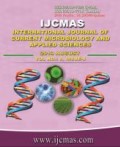


 National Academy of Agricultural Sciences (NAAS)
National Academy of Agricultural Sciences (NAAS)

|
PRINT ISSN : 2319-7692
Online ISSN : 2319-7706 Issues : 12 per year Publisher : Excellent Publishers Email : editorijcmas@gmail.com / submit@ijcmas.com Editor-in-chief: Dr.M.Prakash Index Copernicus ICV 2018: 95.39 NAAS RATING 2020: 5.38 |
China aster (Callistephus chinensis L. Nees.) is one of the important flower crop in India. It belongs to the family Asteraceae is native to China. Phyllody disease in China aster was first reported during 1986 from Bengaluru, India and known to be transmitted by Orosius albicinctus. The disease was characterized by chlorosis, upright growth, small leaf, short internode, stunting, profuse vegetative growth and phyllody (transformation of floral organs into leaf-like structures). Molecular detection was carried out through PCR assay by extracting the total DNA from phyllody infected aster leaf by using nested PCR phytoplasma specific universal primers R16F2n/R16FR2and results revealed that the amplification of phytoplasmal specific PCR product of 1.2 kb fragment corresponding to the 16S rDNA. A 16S rDNA sequence comparison of aster phyllody phytoplasma with the 16S rDNA gene sequences of other phytoplasmas obtained from NCBI database. The BLAST analysis revealed that aster phyllody phytoplasma had 99 per cent sequence similarity with Tomato big bud TBB1 (KX358564.1), Alfalfa phytoplasma (Sudan) AP2 (KY449416.1), Pisumsativum phyllody (KX358571.1) phytoplasma. Furthermore, the phylogenetic tree constructed by using the software MEGA 6.06 showed that aster phyllody phytoplasma clustered with the Tomato big bud TBB1 (KX358564.1) phytoplasma. The characterization of the phytoplasma through phylogenetic analysis of nucleotide sequence of 16S rDNA region showed that niger phyllody phytoplasma belong to 16S rII phytoplasmal group.
 |
 |
 |
 |
 |